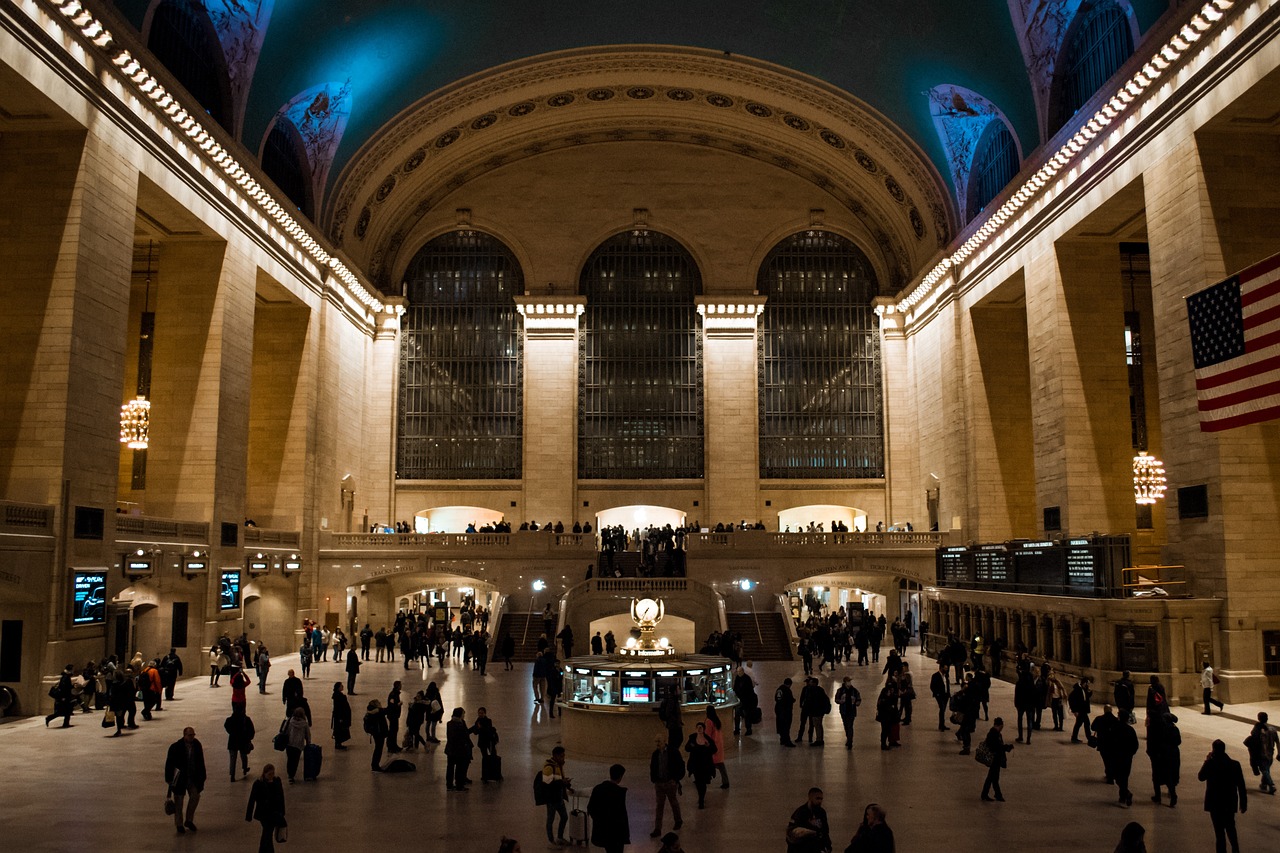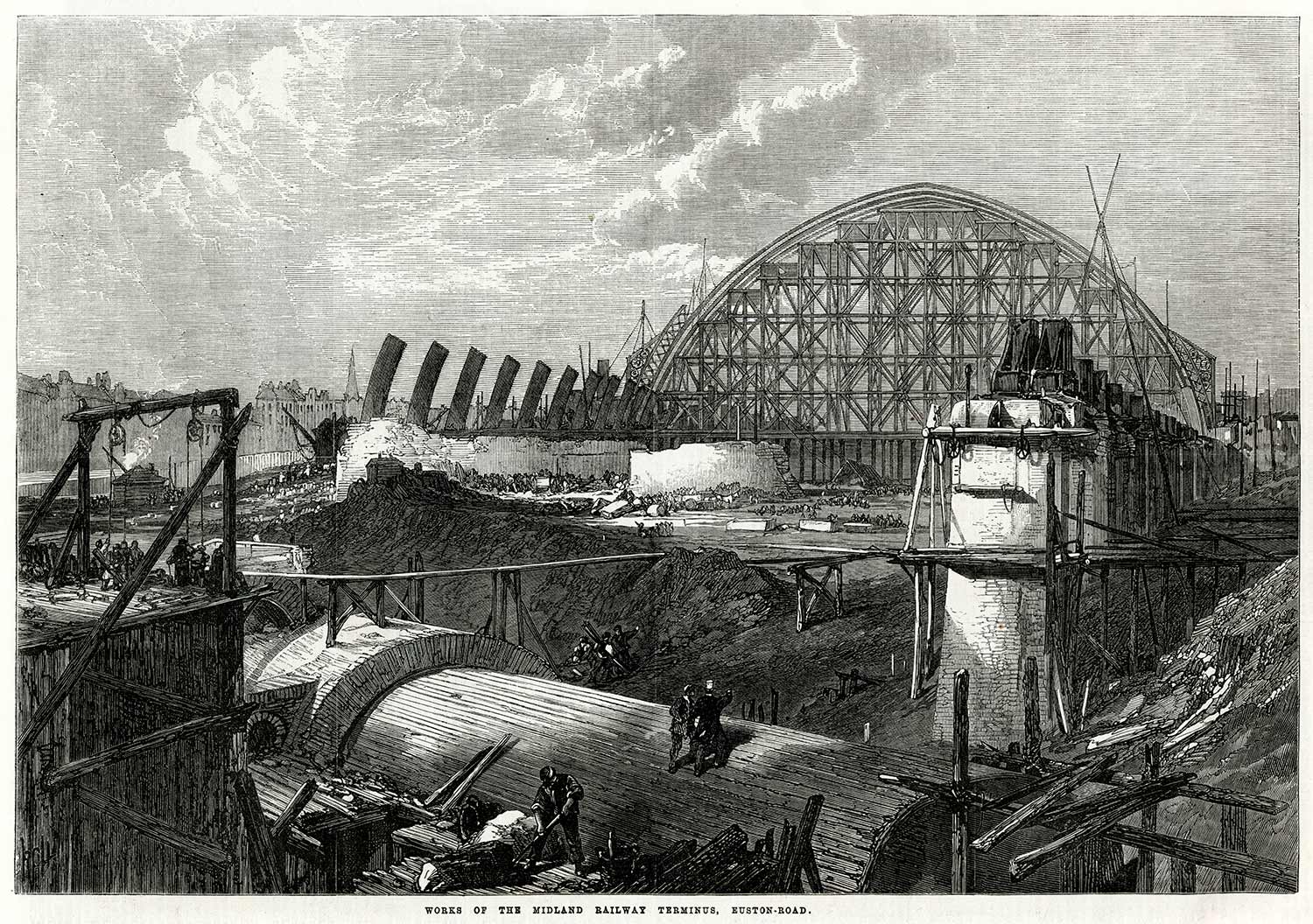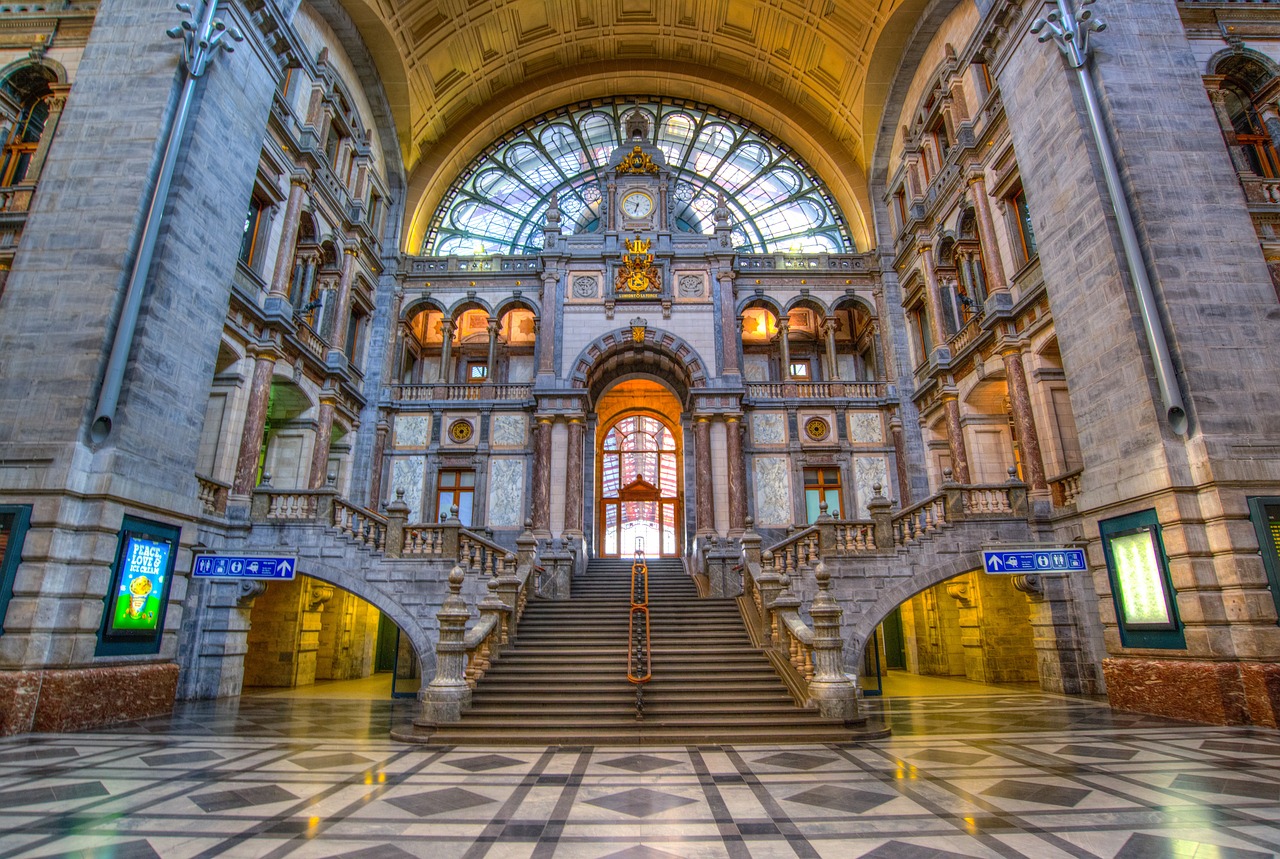Table of Contents
Railway stations are more than just transportation hubs; they are architectural marvels that often serve as iconic landmarks in cities worldwide. These grand designs are not only functional spaces for commuters but also captivating works of art that showcase the creativity and innovation of architects and engineers. In this article, we will take a journey through some of the most stunning railway stations around the world and explore the unique architectural elements that make them true icons.
Railway stations stand as testament to the intersection of functionality and architectural grandeur. Far from being mere transportation hubs, these stations are awe-inspiring architectural marvels that grace cities worldwide. They serve as iconic landmarks, capturing the imagination of travelers and locals alike. As we embark on this journey through some of the world’s most stunning railway stations, we uncover the unique architectural elements that transform them into enduring icons, each telling a story of creativity, innovation and cultural significance:
St. Pancras International, London: This iconic station boasts a stunning Victorian Gothic façade, a masterpiece of 19th-century architecture. Its soaring arched roof, adorned with intricate details, encapsulates the romance of train travel. St. Pancras is not just a station; it’s a symbol of London’s enduring railway heritage.
Grand Central Terminal, New York: An architectural gem in the heart of Manhattan, Grand Central Terminal exudes timeless elegance. Its celestial dome, adorned with constellations, is a marvel to behold. The Beaux-Arts design features sweeping staircases, opulent chandeliers and celestial-themed décor, creating an atmosphere of grandeur and sophistication.
Antwerp Central Station, Belgium: Often referred to as the “Railway Cathedral,” Antwerp Central Station is a blend of architectural styles, including Art Nouveau and Beaux-Arts. Its massive dome and ornate façade are a testament to Belgium’s rich railway history. The station’s main hall, with its grand iron and glass vaulted ceiling, is a sight to behold.
Chhatrapati Shivaji Maharaj Terminus, Mumbai: This UNESCO World Heritage Site is a masterpiece of Victorian-Gothic architecture. Its intricate stone carvings, soaring arches and grand central dome make it a true cultural treasure. The station seamlessly blends Indian and British architectural influences, reflecting Mumbai’s history.
Kanazawa Station, Japan: A modern architectural marvel, Kanazawa Station features a striking wooden gate inspired by traditional Japanese torii gates. The fusion of wood and glass creates a warm, inviting atmosphere. The station’s unique design pays homage to the city’s cultural heritage while embracing contemporary aesthetics.
Helsinki Central Railway Station, Finland: Designed by renowned architect Eliel Saarinen, this station is a testament to Finnish National Romanticism. Its distinctive clock tower and granite façade make it an enduring symbol of Helsinki. The station’s interior, with its intricate detailing and arched halls, exudes a sense of national pride.
Kuala Lumpur Railway Station, Malaysia: This Moorish-style architectural gem features a blend of Islamic and Western influences. Its majestic domes, arched colonnades and ornate façade create a sense of grandeur. The station’s unique design reflects Malaysia’s cultural diversity.
Sydney Central Station, Australia: With its grand colonnades and majestic clock tower, Sydney Central Station is an iconic piece of Australian architecture. The station’s blend of Romanesque and Queen Anne styles gives it a timeless appeal. Its historic interiors and vaulted ceilings offer a glimpse into Australia’s railway history.
These stunning railway stations are not just utilitarian spaces; they are living testaments to human creativity and innovation. They capture the essence of their respective cities and cultures, leaving an indelible mark on the urban landscape. Beyond serving as transportation hubs, these stations are enduring symbols of architectural excellence, cultural heritage and the romance of train travel. They remind us that even in our modern world, the blend of functionality and artistry can give rise to architectural icons that stand the test of time.
To expand your knowledge on this subject, make sure to read on at this location: Beautiful Train Stations Around the World | Architectural Digest
Grand Central Terminal, New York City, USA
Nestled in the heart of Manhattan, Grand Central Terminal is a masterpiece of Beaux-Arts architecture. Its soaring main concourse features a stunning celestial ceiling adorned with constellations and a massive brass chandelier. The station’s grand façade, adorned with its iconic clock, welcomes commuters and tourists alike. Grand Central Terminal seamlessly blends architectural grandeur with efficient transportation, making it one of the most recognizable railway stations globally and a symbol of New York City.
“Nestled in the heart of Manhattan, Grand Central Terminal stands as an enduring testament to the fusion of architectural magnificence and practicality. Its Beaux-Arts design, a pinnacle of Gilded Age opulence, continues to captivate visitors from around the world.
The Celestial Ceiling: The main concourse of Grand Central Terminal is a grand spectacle that never fails to inspire awe. Above, a celestial ceiling adorned with constellations stretches like a celestial canvas. The iconic zodiac mural, lovingly restored, serves as a reminder of the station’s celestial origins, offering a celestial panorama for travelers below.
The Grand Chandelier: Suspended from the ceiling, a massive brass chandelier adds to the grandeur of the main concourse. Its warm glow bathes the bustling terminal in a soft, inviting light, creating an ambiance that is both welcoming and reminiscent of a bygone era of elegance.
The Iconic Façade: Grand Central Terminal is more than just a station; it is an iconic symbol of New York City. Its grand façade, graced by the iconic clock and adorned with stately columns, stands as a beacon in the bustling cityscape. The terminal’s elegant entrance serves as a timeless welcome to commuters and tourists alike.
Efficient Transportation Hub: Beyond its architectural splendor, Grand Central Terminal functions as an efficient transportation hub, connecting New Yorkers and visitors to destinations near and far. It has seamlessly adapted to the modern demands of transportation while preserving its historic charm. The terminal’s comprehensive network of trains and subways ensures that the pulse of the city flows through its majestic halls.
A Symbol of New York: Grand Central Terminal is not just a railway station; it’s a symbol of New York City’s enduring spirit. It has borne witness to a century of change, serving as a witness to the city’s evolution while retaining its timeless allure. It represents the resilience and adaptability of a city that never sleeps.
Historical Significance: The terminal has witnessed pivotal moments in history, from the wartime farewells of soldiers departing for battle to the joyous reunions of loved ones. Its history is interwoven with that of the nation, making it a living museum of memories and milestones.
A Place for Gathering: Grand Central Terminal is not merely a transit point; it’s a destination in itself. Its bustling market, fine dining options and cultural events make it a vibrant gathering place where people come together to share moments, stories and experiences.
In conclusion, Grand Central Terminal transcends its role as a transportation hub. It is a living testament to the enduring power of architectural beauty, a symbol of New York City’s indomitable spirit and a place where history, elegance and efficiency converge. It continues to enchant visitors and commuters alike, reminding us that even in the fast-paced urban landscape, there are places where time seems to stand still and beauty thrives for generations to come.”
Don’t stop here; you can continue your exploration by following this link for more details: Grand Central Terminal: A New York City Icon – Wandering Jana

St. Pancras International, London, UK
St. Pancras International in London is a prime example of Victorian Gothic Revival architecture. Its breathtaking redbrick exterior and the iconic Midland Hotel form an imposing façade that has been immortalized in literature and film. Inside, the station boasts an awe-inspiring arched train shed with elegant cast-ironwork and a soaring glass roof. It is also home to the impressive statue of “The Meeting Place,” a 30-foot bronze sculpture that adds to the station’s artistic allure.
St. Pancras International, situated in the heart of London, is more than just a railway station; it’s a testament to the enduring beauty of Victorian Gothic Revival architecture. Its magnificent redbrick exterior stands as a time-honored symbol of an era marked by opulence and attention to detail. This stunning façade, adorned with intricate carvings and decorative elements, has not only captured the eyes of travelers but has also left an indelible mark on the world of literature and film.
The iconic Midland Hotel, an integral part of St. Pancras, shares the same architectural splendor as the station itself. This grand hotel has played host to countless dignitaries, celebrities and travelers from around the globe. Its exquisite design and luxurious accommodations have been celebrated in novels and portrayed on the silver screen, adding to the station’s aura of timeless elegance.
Step inside St. Pancras and you’ll find yourself transported to an era of architectural opulence and engineering marvels. The station’s awe-inspiring train shed is a true architectural gem. Its gracefully curved arches and delicate cast-ironwork create an atmosphere of grandeur and sophistication. The soaring glass roof allows natural light to cascade into the station, creating a sense of openness and airiness that is simply enchanting.
One of the station’s most captivating features is the impressive bronze sculpture titled “The Meeting Place.” This 30-foot masterpiece, created by artist Paul Day, serves as a meeting point for travelers and a focal point of artistic allure within the station. The sculpture’s depiction of a romantic embrace captures the essence of human connection and adds a touch of sentimentality to the bustling environment of St. Pancras.
Beyond its architectural and artistic appeal, St. Pancras International is a dynamic hub of activity and culture. It serves as a gateway for travelers arriving in London from the European continent via the Eurostar high-speed train service. Its role in connecting people and places is not limited to its physical attributes but extends to the sense of adventure and anticipation that permeates its historic halls.
As we admire the grandeur of St. Pancras International, we are reminded that it is not merely a transportation hub but a living testament to the enduring power of architecture to inspire and captivate the human spirit. This Victorian masterpiece continues to be a source of fascination for travelers, artists and architects alike, inviting us to appreciate the harmonious blend of history and modernity that defines this iconic London landmark.
To delve further into this matter, we encourage you to check out the additional resources provided here: History of St. Pancras – St Pancras International | London

Gare du Nord, Paris, France
Gare du Nord, one of the busiest railway stations in Europe, showcases magnificent Belle Époque architecture. The station’s façade, adorned with intricate ironwork and monumental sculptures, is a testament to the opulence of the era. Inside, the grand concourse features a striking blend of classic design elements with modern amenities. Gare du Nord serves as a gateway to Paris for millions of travelers and stands as a symbol of the city’s timeless elegance.
Gare du Nord, nestled in the heart of Paris, stands not only as one of the busiest railway stations in Europe but also as a magnificent testament to the opulent Belle Époque era. Its architecture, a harmonious fusion of grandeur and functionality, beckons travelers to step into a world where timeless elegance meets modern convenience.
The façade of Gare du Nord is a masterpiece of architectural artistry. Adorned with intricate ironwork and monumental sculptures, it captures the essence of an era that celebrated intricate detailing and craftsmanship. The station’s exterior is more than a welcoming entrance; it’s a portal to a bygone time, where aesthetics were paramount and every structural element told a story.
Stepping inside Gare du Nord’s grand concourse is like entering a living museum of design. The space seamlessly blends classic architectural elements with contemporary amenities. Majestic arched windows flood the interior with natural light, casting a warm glow over the polished marble floors. The high vaulted ceilings, adorned with delicate stucco ornamentation, create a sense of airiness and grandeur that envelops travelers in a feeling of timeless luxury.
Gare du Nord’s interior serves as a testament to the importance of preserving historical landmarks while adapting to the demands of modern travel. Passengers can navigate the station with ease, thanks to efficient signage and state-of-the-art facilities, while still basking in the ambiance of a bygone era.
Beyond its architectural splendor, Gare du Nord plays a vital role as a gateway to Paris for millions of travelers each year. It serves as a welcoming embrace, inviting visitors to discover the city’s rich culture, history and artistry. The station itself is a prelude to the wonders of Paris, a city that, like Gare du Nord, seamlessly blends timeless elegance with contemporary vitality.
In essence, Gare du Nord is not just a railway station; it is a symbol of Paris’s enduring allure and sophistication. It stands as a living testament to the artistic and architectural achievements of the Belle Époque era while continuing to evolve and adapt to the needs of modern travelers. As visitors pass through its iconic gates, they are not merely arriving in Paris; they are stepping into a world where the past and the present coexist harmoniously, reminding us that the beauty of history can be cherished and enjoyed in the here and now.
Don’t stop here; you can continue your exploration by following this link for more details: Grand Designs: Exploring the World’s Most Stunning Train Stations

Kanazawa Station, Kanazawa, Japan
Kanazawa Station in Japan seamlessly marries traditional Japanese architectural elements with modern design. Its Tsuzumi Mon Gate, inspired by the shape of traditional Japanese hand drums, welcomes visitors with a stunning wooden motif. The station’s modern glass dome, known as the “Motenashi Dome,” bathes the interior in natural light. Kanazawa Station serves as a gateway to the historic city of Kanazawa and is a testament to Japan’s commitment to preserving its cultural heritage while embracing innovation.
Kanazawa Station stands as a splendid embodiment of Japan’s remarkable ability to blend the old and the new, seamlessly merging traditional architectural elements with cutting-edge design. This architectural masterpiece serves as not just a transportation hub but a welcoming gateway to the historic city of Kanazawa, offering travelers a captivating glimpse into the country’s rich cultural heritage and innovative spirit.
At first glance, the Tsuzumi Mon Gate is a breathtaking testament to Japan’s commitment to preserving its cultural legacy. Inspired by the distinctive shape of traditional Japanese hand drums known as “tsuzumi,” this wooden masterpiece stands tall and proud at the station’s entrance. The intricate wooden motif is a nod to the nation’s artistic roots and it welcomes visitors with a sense of reverence for the past.
However, Kanazawa Station isn’t merely a homage to tradition; it is also a paragon of modernity. The “Motenashi Dome,” an exquisite glass structure, graces the station’s interior with an abundance of natural light. As travelers step beneath its awe-inspiring canopy, they are bathed in a gentle, ethereal glow that hints at the promise of the city beyond. This harmonious blend of traditional elements with contemporary design creates an ambiance that is both uplifting and inspiring.
The station itself is a microcosm of Kanazawa’s unique identity—a city that cherishes its historical treasures while embracing the possibilities of the future. Beyond its architectural splendor, Kanazawa Station serves as a launchpad for exploration. Travelers can embark on a journey through a city known for its well-preserved samurai and geisha districts, lush Kenrokuen Garden and a thriving arts and crafts scene that upholds centuries-old traditions.
In essence, Kanazawa Station embodies the essence of Japan—where heritage meets innovation and where the past and future coexist in perfect harmony. It is a compelling testament to the nation’s unwavering commitment to preserving its cultural heritage while embracing the transformative power of modernity. As visitors pass through its gates and under its glass dome, they are not just arriving in Kanazawa; they are stepping into a world where time-honored traditions are celebrated alongside the boundless possibilities of the future.
Should you desire more in-depth information, it’s available for your perusal on this page: 21 Of the Most Stunning Train Stations Around the World

Antwerp Central Station, Antwerp, Belgium
Antwerp Central Station is a striking blend of architectural styles, combining the grandeur of Baroque and the elegance of Art Nouveau. Its monumental dome and exquisite clock tower make it a visual marvel from the outside. Inside, the station features a lavish waiting hall with a stunning iron and glass vaulted ceiling. Antwerp Central Station is not only a transportation hub but also a testament to Belgium’s rich architectural heritage.
Antwerp Central Station stands as a testament to the rich architectural heritage of Belgium, captivating visitors with its splendid fusion of Baroque and Art Nouveau styles. This iconic transportation hub is not just a place to catch a train; it’s a destination in itself, offering a glimpse into the country’s cultural and historical legacy. Let’s delve deeper into this architectural masterpiece:
“Antwerp Central Station, a magnificent architectural gem, seamlessly blends the grandeur of Baroque with the elegance of Art Nouveau to create a visual spectacle that transcends the realm of transportation. Its imposing dome and intricate clock tower make an indelible mark on the city’s skyline, drawing admirers from far and wide. Inside, the station unveils a lavish waiting hall adorned with a breathtaking iron and glass vaulted ceiling, where every detail exudes opulence and craftsmanship. Beyond its utilitarian function as a transportation hub, Antwerp Central Station serves as a living testament to Belgium’s rich architectural heritage.”
Baroque and Art Nouveau Fusion: The harmonious fusion of Baroque and Art Nouveau elements in the station’s design is a testament to the architectural creativity of the era. The Baroque influence is evident in the station’s exterior, with its grand dome and intricate façade, while the Art Nouveau style graces the interior, marked by organic motifs, sinuous curves and elegant materials.
A Grand Entrance: Antwerp Central Station isn’t just a train station; it’s a grand entrance to the city. Arriving at this station feels like stepping into a palace, where travelers are greeted by an air of sophistication and historical charm.
Historical Significance: Beyond its architectural brilliance, Antwerp Central Station holds historical significance. It has been a witness to the city’s growth and transformation over the centuries, serving as a vital transportation link for both residents and visitors.
Artistic Detailing: The iron and glass vaulted ceiling of the waiting hall is a masterpiece of engineering and aesthetics. The intricate detailing and stained glass create a magical interplay of light and shadows, adding to the station’s allure.
Cultural Hub: Antwerp Central Station is not just a place to catch a train; it’s a cultural hub. Throughout the year, it hosts events, exhibitions and performances that celebrate Belgium’s artistic and cultural heritage, making it a vibrant gathering place for both locals and tourists.
Gateway to Antwerp: For many travelers, Antwerp Central Station is their first introduction to the city. Its architectural splendor sets the tone for their exploration of Antwerp’s history, culture and art.
Renovations and Preservation: Over the years, the station has undergone meticulous restoration and preservation efforts to ensure that its architectural grandeur endures for generations to come. These endeavors reflect Belgium’s commitment to safeguarding its cultural treasures.
In conclusion, Antwerp Central Station is not just a transportation hub; it’s a masterpiece that bridges the past and the present. Its architectural splendor, historical significance and cultural vibrancy make it a must-visit destination for anyone exploring the rich tapestry of Belgium’s heritage and artistry.”
For additional details, consider exploring the related content available here The World’s Most Beautiful Train Stations | Time

Kuala Lumpur Railway Station, Kuala Lumpur, Malaysia
Kuala Lumpur Railway Station is a captivating fusion of Western and Moorish architectural styles. Its distinctive domes, arches and minaret-like towers are reminiscent of Islamic design. The station’s façade is adorned with intricate details, including decorative tiles and stained glass windows. This architectural gem reflects Malaysia’s cultural diversity and serves as a striking landmark in the heart of Kuala Lumpur.
The Kuala Lumpur Railway Station stands as a testament to the captivating fusion of architectural styles, a true masterpiece that bridges the gap between the Western and Moorish traditions. Its architecture is a visual symphony that resonates with echoes of Islamic design, featuring distinctive domes that reach for the heavens, graceful arches that span time and tradition and minaret-like towers that stand as sentinels to the city’s history.
Islamic Influence: The station’s architectural splendor is undeniably influenced by Moorish and Islamic design principles. Its elegant domes and towering minarets evoke the grandeur of Islamic architecture, transporting visitors to a world of rich heritage and cultural significance.
Intricate Details: Upon closer inspection, the façade of the Kuala Lumpur Railway Station reveals a treasure trove of intricate details. Decorative tiles, meticulously handcrafted to perfection, adorn the walls, each telling a story of artistry and craftsmanship. Stained glass windows filter the sunlight, casting a colorful mosaic of hues and adding a sense of mystique to the station’s interior.
Cultural Diversity: This architectural gem is not only a reflection of artistic brilliance but also a symbol of Malaysia’s cultural diversity. It encapsulates the harmonious coexistence of various ethnic and cultural influences within the nation, harmonizing Western and Moorish elements into a unique Malaysian identity.
A Landmark of Distinction: The Kuala Lumpur Railway Station stands as a striking and recognizable landmark in the heart of the city. Its distinctive appearance ensures that it is not just a transportation hub but also a cultural and historical icon that connects the past with the present.
Preserving Heritage: The preservation of the station’s architectural heritage is a testament to Malaysia’s commitment to honoring its history and celebrating its architectural legacy. It is a reminder of the importance of safeguarding historical landmarks for future generations to admire and appreciate.
A Gateway to Exploration: Beyond its architectural significance, the Kuala Lumpur Railway Station serves as a gateway to exploration. Travelers passing through its ornate halls embark on journeys that take them to the far corners of Malaysia, further emphasizing the station’s role in connecting people and places.
Timeless Elegance: The station’s timeless elegance transcends the boundaries of time and fashion. It is a living testament to the enduring appeal of architectural styles that have stood the test of time, inspiring awe and admiration in all who encounter its beauty.
In conclusion, the Kuala Lumpur Railway Station is not merely a transportation hub; it is a living work of art that bridges cultures, a harmonious blend of Western and Moorish architecture that tells a story of Malaysia’s cultural diversity and historical significance. As travelers and visitors pass through its doors, they are transported not only to their destinations but also to a world of architectural splendor and cultural richness, where the past and present seamlessly intertwine, creating a timeless masterpiece in the heart of Kuala Lumpur.
To delve further into this matter, we encourage you to check out the additional resources provided here: Gorgeous Train Stations to See in Your Lifetime

In conclusion, railway stations around the world are not just places to catch a train; they are architectural icons that tell stories of history, culture and innovation. These grand designs serve as more than just transportation hubs; they are symbols of the cities they inhabit, offering a blend of functionality and aesthetic beauty that captivates the imagination of travelers and admirers alike. As we journey through these iconic railway stations, we are reminded that architecture has the power to elevate the everyday into the extraordinary.
In essence, railway stations transcend their functional role as mere transportation hubs; they are living testaments to the rich tapestry of human history, culture and innovation. As we reflect on the significance of these architectural icons, let’s delve deeper into the enduring legacy they leave behind and the profound impact they have on the cities and people they serve:
Architectural Time Capsules: Railway stations are architectural time capsules that encapsulate the evolution of design, engineering and society over the years. From the opulence of Victorian-era stations to the sleek modernism of contemporary designs, each station tells a story of its era, preserving a slice of history for generations to come.
Gateways to Adventure: These stations are more than just gateways to destinations; they are gateways to adventure and discovery. The moment travelers step inside, they embark on a journey not only to new places but also into the past and future, where the echoes of countless travelers resonate.
Cultural Crossroads: Railway stations are microcosms of cultural diversity. Here, people from all walks of life converge, sharing stories, languages and experiences. These stations serve as cultural crossroads where the world’s tapestry is woven together, fostering a sense of unity amid diversity.
Economic Catalysts: Historically, the construction of railway stations often spurred economic growth and development in surrounding areas. These stations became epicenters of commerce, attracting businesses, markets and industries, thus shaping the urban landscape.
Aesthetic Marvels: The architectural beauty of these stations is awe-inspiring. From grand facades and soaring vaulted ceilings to intricate mosaics and stained glass windows, their aesthetics are a testament to human creativity and craftsmanship.
Icons of Identity: Railway stations are often symbols of a city’s identity. They represent a unique blend of local culture and global connectivity, capturing the spirit and character of the places they serve.
Transportation Hubs: While they are architectural wonders, railway stations remain vital transportation hubs, facilitating the movement of millions of people daily. Their functionality is seamlessly intertwined with their beauty.
Innovative Engineering: These stations showcase innovative engineering feats. They are marvels of structural design, exemplifying the ingenuity required to build and maintain transportation infrastructure on such a grand scale.
Inspiration for Art and Literature: Railway stations have inspired countless works of art, literature and cinema. They are settings for romance, drama and adventure, serving as backdrops for some of the most memorable moments in storytelling.
Sentinels of Progress: Railway stations stand as sentinels of progress and human achievement. They remind us of the relentless pursuit of connectivity, mobility and advancement that has shaped our world.
In summary, railway stations are more than just architectural gems; they are custodians of history, champions of culture and facilitators of human connection. As we journey through these iconic stations, we are reminded of the enduring power of architecture to elevate the ordinary into the extraordinary. They are living monuments to the human spirit, bridging the past, present and future and enriching the lives of all who pass through their hallowed halls.
If you’d like to dive deeper into this subject, there’s more to discover on this page: World Trade Center – Development, 9/11 Attacks & Rebuilding …
More links
Don’t stop here; you can continue your exploration by following this link for more details: Beautiful Train Stations Around the World | Architectural Digest
